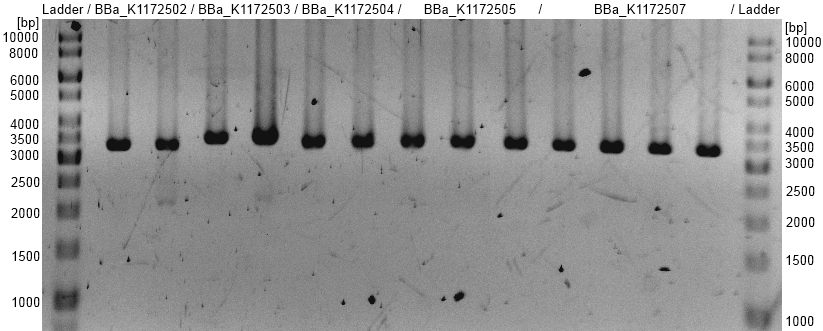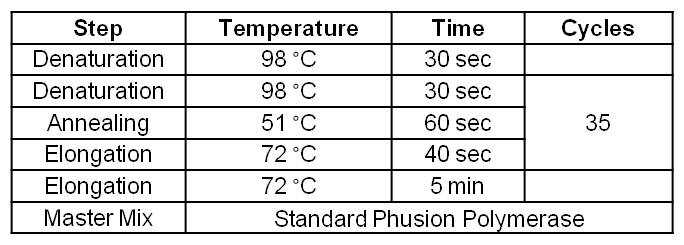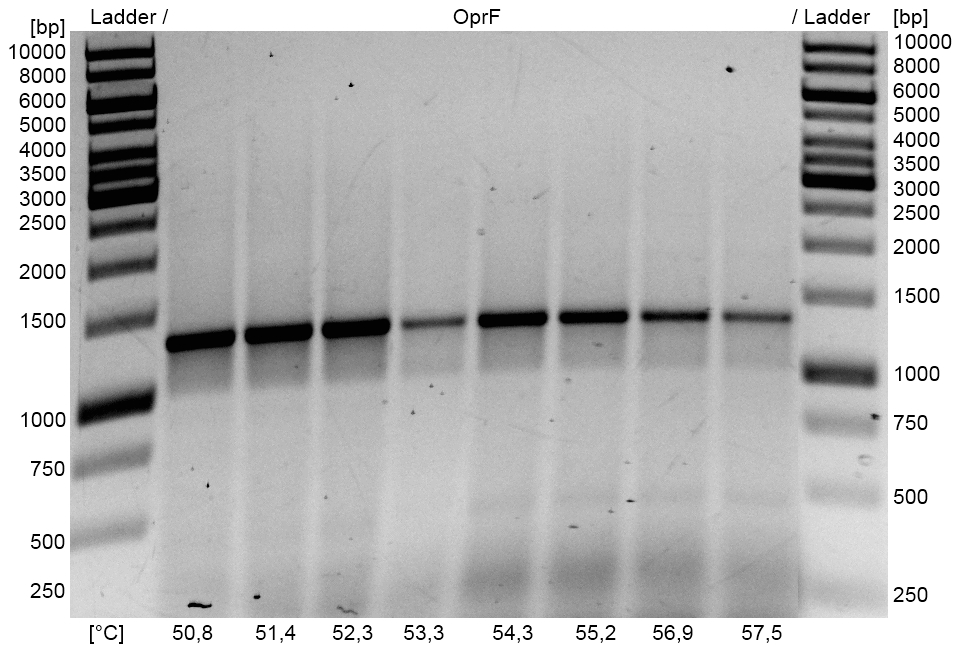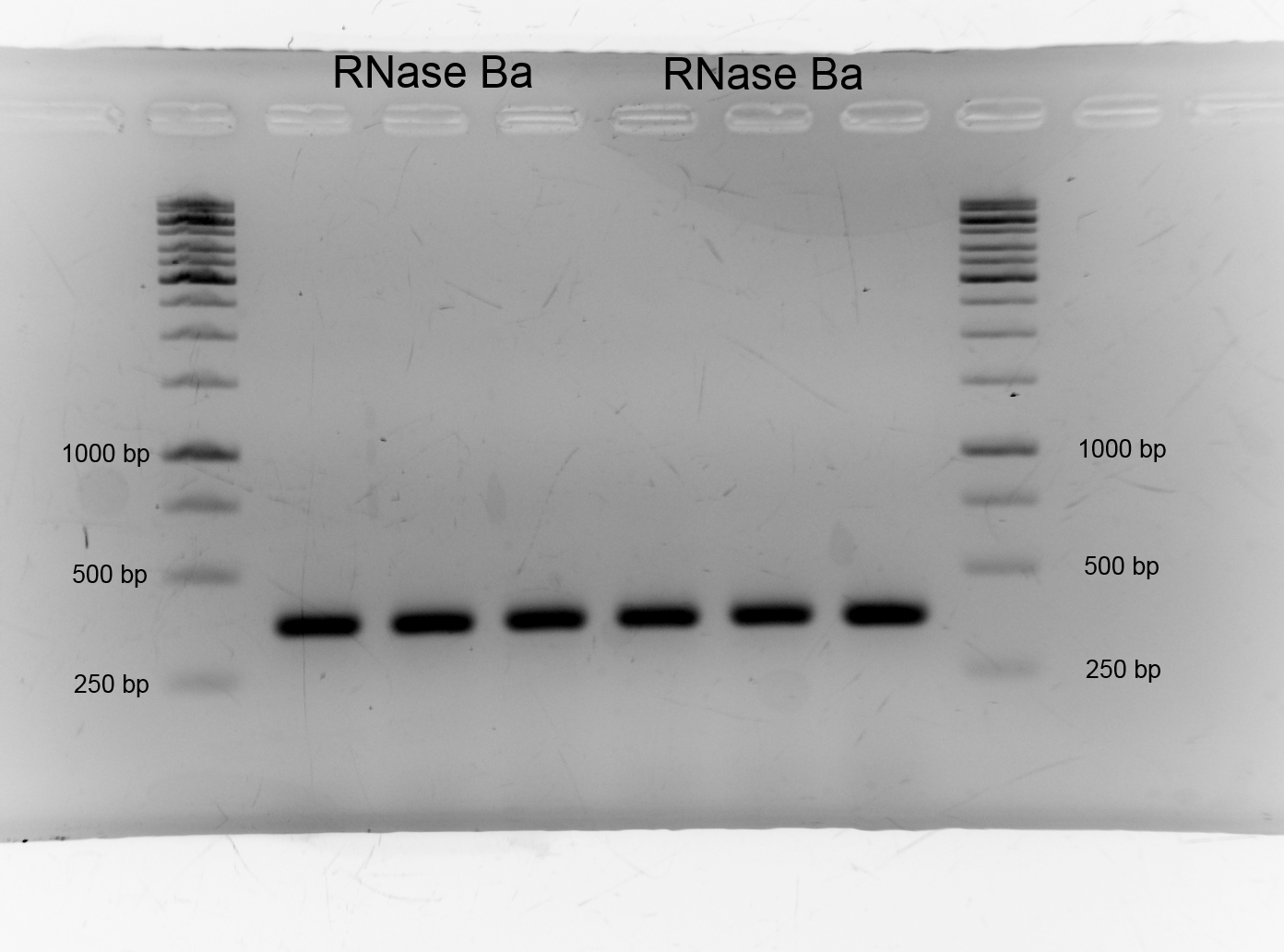Team:Bielefeld-Germany/Labjournal/August
From 2013.igem.org
August
Milestones
Week 14
Organization
- We had a second radio interview in the Bielefeld university campus radio (radio 87.9 hertz) to introduce our project and the iGEM competition.
- Having an expert interview with Dr. Falk Harnisch from the Helmholtz Institute in Leipzig, who has got a great knowledge in the field of MFC.
MFC
Mediators
Cytochromes
- Restriction of ccmAH and psB1C3 and Suffix-Insertion
- The backbone and shipping vector psB1C3 was cut with EcoRI, SpeI, the insert ccmAH with EcoRI and XbaI to perfom a standard suffix insertion.
- We used approx. 200ng insert and 42ng vector, which repressnts a 2-fold molar excess of insert.
- The Ligation was incubated for 15 min at 37°C, followed by a heat-inactivation at 80°C for 20 min.
- The subsequent gel electrophoresis did not yield any positiv results, probably due to the use of buffer and enzymes from two different manufactures.
- Validation of all intermediate products via gel electrophoresis
- A gel electrophoresis was performed to ensure that all former products have the correct size and this could be ruled out as an error source.
- It showed that all products were indeed correct.
- Amplification of psB1C3 with insert-specific primers
- The backbone and shipping plasmid psB1C3 was amplified with the new designed insert-specific primers for mtrCAB. These primers have a specific overlap complementary to 20nt at the beginning and end of the insert. This was necessary, because we had to deal with constant religation of the vector. We investigated this issue and found out, that prefix and suffix of the psB1C3 vector have a very similarity, which facilates religation. The correct band was extracted from the gel and cleaned up.
- NanoDrop:
- 4-0108-301: 1.1 ng/ul
- 4-0108-302: 1.0 ng/ul
- Gibson-Assembly of psB1C3 and fragment 1,2 and 3 of the mtrCAB cluster
- We use a custom 15 ul reaction mixture, prepared in our lab. After thawing on ice, a total amount of 5 ul DNA is added and the whole mixture is incubated at 50°C for approx. 60min.
- Mixture:
- psB1C3 (4-0108-301): 2.2 ng
- Fragment1 (4-2607-304): 13.1 ng
- Fragment2 (4-2707-004): 16.9 ng
- Fragment3 (4-2607-301): 14.4 ng
- Notes:The inserts were not equimolar and not added in a 3-fold excess to the vector
- Transformation to self-made electrocompetent E.coli cells. A total volume of 1ul could be used.
Biosafety
- We did Gibson-Assembly with the different purified plasmids:
- Fragment: "pSB1C3_plac_alr+ pSB1C3_alr_rev"+"pSB1C3_plac_pre+ pSB1C3_alr_suf",
- "pSB1C3_alr_fwd+ pSB1C3_alr_rev"+"pSB1C3_alr_pre+ pSB1C3_alr_suf",
- "araC_d1+ araC_d2"+"araC_d3+ araC_d4", with pKO4
- After the Gibson Assembly we transformated the Gibson fragments into competent E.coli KRX cells and plated the cells on LB+CM20-plates
Porines
- Gradient PCR on the <partinfo>BBa_J04450</partinfo> Biobrick with Forward and Reverse Primer pSB1C3 OprF to amplify pSB1C3 backbone with OprF specific overlaps for Gibson assembly. The optimal Primer Binding temperature was 60 °C.
Week 15
Organization
- The TV station WDR made a video with us about our project. This can be seen in the OWL local time, a television program of the WDR.
MFC
Mediators
Cytochromes
Biosafety
- We did plasmid isolation:
- BBa_I13541 A: 95,1 ng/µL (9-88-451)
- BBa_I13541 B: 165,1 ng/µL (9-88-452)
- BBa_K914004 A white: 198,8 ng/µL (9-88-453)
- BBa_K914004 B white: 204,9 ng/µL (9-88-454)
- BBa_K914004 A red: 476,5 ng/µL (9-88-455)
- BBa_K914004 B red: 400,9 ng/µL (9-88-456)
- AraC_del A: 82,4 ng/µL (9-88-457)
- AraC_del B: 64,5 ng/µL (9-88-458)
- pSB1C3_alr A: 120,4 ng/µL (9-88-459)
- pSB1C3_alr B: 168,4 ng/µL (9-88-460)
- pSB1C3_alr C: 137,2 ng/µL (9-88-461)
- ptac_alr A: 24,7ng/µL (9-108-451)
- ptac_alr B: 39,6 ng/µL (9-108-452)
Porines
- Optimization of PCR on the OprF gene of Pseudomonas fluorescens with temperature gradient PCR using Forward and Reverse OprF Primer. The optimal Primer binding temperature was 51 °C.
- OprF PCR product and the corresponding pSB1C3 Gibson backbone were isolated by Agarose gel electrophorese and purificated.
- Gibson Assembly with optimized OprF PCR product and pSB1C3 PCR product with OprF specific overlaps using Gibson Assembly with 3:1 molar ratio of insert to vector with 100 ng insert.
- OprF BioBrick was successfully cloned into pSB1C3 shipping vector.

Figure 3: Agarosegel with GeneRuler™ 1 kb DNA Ladder from Thermo Scientific as marker. Bands are showing restriction analysis from cloning of OprF into pSB1C3 shipping vector with Gibson Assembly. Bands are at the expected size of 1300 bp (OprF) and 2000 bp (pSB1C3). OprF BioBrick <partinfo>BBa_K1172501</partinfo> was examined.
- OprF BioBrick plasmid <partinfo>BBa_K1172501</partinfo> was examined by restriction analysis with restriction enzymes EcoRI und XbaI. Bands are at the expected size of 1300 bp (OprF) and 2000 bp (pSB1C3).
- OprF BioBrick plasmid <partinfo>BBa_K1172501</partinfo> was examined by sequencing.
Week 16
Organization
- Final preparations for CeBiTec pupil academy in the next week.
MFC
Mediators
Cytochromes
Biosafety
- We isolated the genome of Bacillus amyloliquefaciens
- DMS-1061: 20ng/µL (9-138-451)
- Wildtype H 10A1: 766,6 ng/µL (9-138-452)
- Wildtype R+M+ 10A3: 825,2 ng/µL (9-138-453)
- We did restriktion analysis of the plasmids from 8.8.2013
- BBa_I13541, BBa_K914004 white colony, BBa_K914004 red colony, araC, alr
- Result: failed
- Colony-PCR:
- BBa_I15341, BBa_K194004 white, BBa_K194004 red, pSB1C3_alr, ptac_alr+insertprimern
- Result: failed
- BBa_I15341, BBa_K194004 white, BBa_K194004 red, pSB1C3_alr, ptac_alr+insertprimern
- Restriktionanalysis:
- Alr 1,2,3,4
- Result: no bands as expected
Porines
- Adding the following parts with promoter and RBS to the OprF Biobrick <partinfo>BBa_K1172501</partinfo> by Standard Biobrick assembly Suffix Insertion modified from Silver lab: <partinfo>BBa_K525998</partinfo>, <partinfo>BBa_K04500</partinfo>, <partinfo>BBa_K608002</partinfo>, <partinfo>BBa_K608006</partinfo>, <partinfo>BBa_K608007</partinfo>.
- Promotor insertion was examined by restriction analysis and the following OprF Biobrick Devices with promotor and RBS could be added:
- <partinfo>BBa_K1172502</partinfo>: <partinfo>BBa_K1172501</partinfo> + <partinfo>BBa_K525998</partinfo>
- <partinfo>BBa_K1172503</partinfo>: <partinfo>BBa_K1172501</partinfo> + <partinfo>BBa_K04500</partinfo>
- <partinfo>BBa_K1172504</partinfo>: <partinfo>BBa_K1172501</partinfo> + <partinfo>BBa_K608007</partinfo>
- <partinfo>BBa_K1172505</partinfo>: <partinfo>BBa_K1172501</partinfo> + <partinfo>BBa_K608006</partinfo>
- <partinfo>BBa_K1172507</partinfo>: <partinfo>BBa_K1172501</partinfo> + <partinfo>BBa_K608002</partinfo>

Figure 3: Agarosegel with GeneRuler™ 1 kb DNA Ladder from Thermo Scientific as marker. Bands are showing restriction analysis from suffix insertion of OprF (<partinfo>BBa_K1172501</partinfo>) into <partinfo>BBa_K525998</partinfo>, <partinfo>BBa_K04500</partinfo>, <partinfo>BBa_K608002</partinfo>, <partinfo>BBa_K608006</partinfo> and <partinfo>BBa_K608007</partinfo> with Standard Biobrick assembly Suffix Insertion modified from Silver lab. Bands are at the expected size. OprF BioBrick devices (<partinfo>BBa_K1172502</partinfo>, <partinfo>BBa_K1172503</partinfo>, <partinfo>BBa_K1172504</partinfo>, <partinfo>BBa_K1172505</partinfo> and <partinfo>BBa_K1172507</partinfo>) were examined.
- OprF BioBrick plasmid (<partinfo>BBa_K1172501</partinfo>) with different promotors and RBS was examined by restriction analysis with restriction enzymes EcoRI. All bands are at the expected size and show a successful suffix insertion.
Week 17
Organization
- Our Team will participate at the conference ‘60 Years of DNA’ in Berlin at 14. September.
MFC
Mediators
Cytochromes
Biosafety
- Amplification of DNase Ba:
- Size: 350bp
- Gel purification of the fragments:
- RNase Ba fwdrevinsert 27,5ng/µL (9-238-451)
- RNase Ba presufVektor 67,3ng/µL (9-238-452)
Porines
- Starting with characterization of Escherichia coli KRX with porin OprF (<partinfo>BBa_K1172501</partinfo> up to <partinfo>BBa_K1172507</partinfo>).
- Testing Hexadecan-Assay for characterization of hydrophobicity of the outer membrane. Using Escherichia coli KRX Wildtyp and comparing it with:
- <partinfo>BBa_K1172504</partinfo>: <partinfo>BBa_K1172501</partinfo> + <partinfo>BBa_K608007</partinfo>
- <partinfo>BBa_K1172505</partinfo>: <partinfo>BBa_K1172501</partinfo> + <partinfo>BBa_K608006</partinfo>
- <partinfo>BBa_K1172507</partinfo>: <partinfo>BBa_K1172501</partinfo> + <partinfo>BBa_K608002</partinfo>
- E. coli KRX with OprF plasmids and Anderson promoters show higher membrane hydrophobicity than Wildtyp. Hydrophobicity is about 37 up to 77 % higher in comparison to the KRX Wildtyp. Assay must be improved because of too high standard deviation.
- Membrane permeability was further tested with two uptake assays. ONPG and NPN uptake assay were performed. The values indicate a successful expression of OprF porin in the outer membrane. The permeability increases by introducing the plasmids with OprF.
- Protein isolation of outer membrane porin oprF by Release of periplasmic protein fraction from E. coli by cold osmotic shock for later SDS-PAGE. OprF could not been detected on the PAGE. It seems to be that only periplasmic proteins were isolated whereas outer membrane proteins werere not soluble in the supernatant.

Figure 4: SDS-PAGE with Unstained (Left) and Prestained (Right) Protein Ladder from Thermo Scientific as marker. Comparison of protein expression between Escherichia coli KRX wild type and Escherichia coli KRX with <partinfo>BBa_K1172502</partinfo>, <partinfo>BBa_K1172503</partinfo>, <partinfo>BBa_K1172504</partinfo>, <partinfo>BBa_K1172505</partinfo> and <partinfo>BBa_K1172507</partinfo> after periplasmic protein fractioning.
Contents |
 "
"





